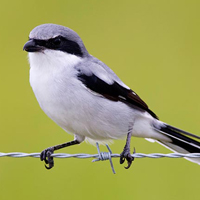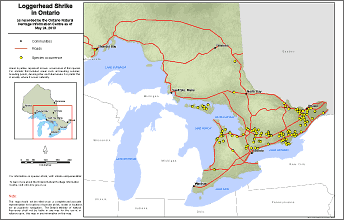Loggerhead shrike
Scientific name: Lanius ludovicianus


Cover photos credit: iStockPhoto.com (left) and Brendan Toews (right)
Status
Endangered
“Endangered” means the species lives in the wild in Ontario but is facing imminent extinction or extirpation.
Date added to the Species at Risk in Ontario List
The Loggerhead shrike was already assessed as Endangered when the Endangered Species Act took effect in 2008.
What it looks like
The Loggerhead shrike is a striking, robin-sized bird.
It has an all black bill that is hooked at the tip, a medium-grey crown and back, and a raccoon-like black face mask.
The throat and breast are white, the tail is black with prominent white outer feathers, and the wings are black with a bold white patch that flashes when the bird is in flight.
Where it lives
In Ontario, the Loggerhead shrike prefers pasture or other grasslands with scattered low trees and shrubs.
It lives in fields or alvars (areas of exposed bedrock) with short grass, which makes it easier to spot prey.
It builds its nest in small trees or shrubs and hunts by waiting patiently in tree branches until it swoops down and attacks its unsuspecting prey – usually large insects, such as grasshoppers.
Loggerhead shrikes also require spiny, multi-branched shrubs where they can impale prey before eating it. Barbed wired fencing can also be used for this.
Where it’s been found in Ontario
The Loggerhead shrike currently breeds in central and western North America.
Until the 1970s, the Loggerhead shrike could be found at many locations throughout southern Ontario and other parts of northeastern North America, but it has declined dramatically.
Although the occasional bird is still found within the broader former range, most remaining Loggerhead shrikes are now found in two core grassland habitats - the Carden Plain north of Lindsay, and the Napanee Limestone Plain. Every fall these birds migrate to the southern United States for the winter.
View a Larger version of this map (PDF)
What threatens it
Threats to the Loggerhead shrike may include habitat loss resulting from development (conversion of grasslands and pastures to cropland, residential development etc.) and succession (when open fields gradually change into thickets and forests).
They may also be impacted by accumulation of toxins from the prey they eat and a reduction in prey availability because of increased use of pesticides.
Since Loggerhead shrikes often hunt from low perches along roads, they are susceptible to being killed by cars.
Action we are taking
Endangered Species and their general habitat are automatically protected.
Recovery strategy
A recovery strategy advises the ministry on ways to ensure healthy numbers of the species return to Ontario.
Read the executive summary and full document (June 2, 2016)
Government response statement
A government response statement outlines the actions the government intends to take or support to help recover the species.
Read the government response statement (March 2, 2017)
Review of progress
A review of progress made toward protecting and recovering a species is required no later than the time specified in the species’ government response statement, or not later than five years after the government response statement is published if no time is specified.
Read the report on progress towards the protection and recovery of 12 species at risk, including Loggerhead shrikes (2022).
Habitat protection
General habitat descriptions are technical, science-based documents that provide greater clarity on the area of habitat protected for a species.
Read the general habitat description (July 2, 2013)
What you can do
Report a sighting
- Report a sighting of an endangered animal or plant to the Natural Heritage Information Centre. Photographs with specific locations or mapping coordinates are always helpful.
- Bird Studies Canada is working to advance the understanding, appreciation and conservation of wild birds and their habitat in Ontario and elsewhere; for more information on how you can help, visit:
www.bsc-eoc.org
Volunteer
Volunteer with your local nature club or provincial park to participate in surveys or stewardship work focused on species at risk.
Be a good steward
- Private land owners have a very important role to play in species recovery; if you find a Loggerhead shrike on your land, you may be eligible for stewardship programs that support the protection and recovery of species at risk and their habitats
- As with all wildlife, don’t disturb nests, young or adults; be respectful and observe from a distance
- There is a new program geared to eligible farms registered under the Canada-Ontario Environmental Farm Plan to encourage greater protection and conservation of habitat for species at risk
Report illegal activity
Report any illegal activity related to plants and wildlife to
Quick facts
- A survey completed in 1992 found 52 breeding pairs in the province; in 2006 this number dropped to just 18 pairs; however, 2009 saw a notable increase with 31 pairs confirmed in Ontario.
- Due to the serious drop in the Loggerhead shrike population, a captive-breeding program was launched in Ontario and Quebec; wild populations may be increased by releasing birds bred in captivity; between 2001 and 2009, 18 released captive-bred birds have returned to Ontario.
- Shrikes are sometimes called "butcher bird" because of their unusual habit of impaling their prey on thorns, barbed wire or sharp twigs; they do this because, while they have the strong hooked beak of a predator, their feet are weak and they cannot hold their prey and tear it into pieces at the same time.
- In Ontario, the principal diet of Loggerhead shrikes consists of insects, especially grasshoppers, but they have also been known to catch small birds, mammals and even frogs on occasion.
- Loggerhead shrikes are only present in Ontario from April until September, and then they migrate to the southern US for winter.
- Loggerhead shrikes are very protective parents; once the eggs hatch, the parents are both kept busy bringing food to their young and will very aggressively defend their nest.
